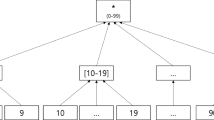Abstract
The publication of microdata is pivotal for medical research purposes, data analysis and data mining. These published data contain a substantial amount of sensitive information, for example, a hospital may publish many sensitive attributes such as diseases, treatments and symptoms. The release of multiple sensitive attributes is not desirable because it puts the privacy of individuals at risk. The main vulnerability of such approach while releasing data is that if an adversary is successful in identifying a single sensitive attribute, then other sensitive attributes can be identified by co-relation. A whole variety of techniques such as SLOMS, SLAMSA and others already exist for the anonymization of multiple sensitive attributes; however, these techniques have their drawbacks when it comes to preserving privacy and ensuring data utility. The extant framework lacks in terms of preserving privacy for multiple sensitive attributes and ensuring data utility. We propose an efficient approach (p, k)-Angelization for the anonymization of multiple sensitive attributes. Our proposed approach protects the privacy of the individuals and yields promising results compared with currently used techniques in terms of utility. The (p, k)-Angelization approach not only preserves the privacy by eliminating the threat of background join and non-membership attacks but also reduces the information loss thus improving the utility of the released information.






Similar content being viewed by others

References
Susan VS, Christopher T (2016) Anatomisation with slicing: a new privacy preservation approach for multiple sensitive attributes. SpringerPlus 5(1):964–984
Xiao X, Tao Y (2006). Anatomy: simple and effective privacy preservation. In: Proceedings of the 32nd International Conference on Very Large Data Bases. VLDB Endowment, pp 139–150
Tao Y, Chen H, Xiao X, Zhou S, Zhang D (2009) Angel: enhancing the utility of generalization for privacy preserving publication. IEEE Trans Knowl Data Eng 21(7):1073–1087
Liu Q, Shen H, Sang Y (2015) Privacy-preserving data publishing for multiple numerical sensitive attributes. Tsinghua Sci Technol 20(3):246–254
Dhumal MTS, Patil MYS (2015) Implementation of slicing for multiple column multiple attributes: privacy preserving data publishing
Han J, Luo F, Lu J, Peng H (2013) SLOMS: a privacy preserving data publishing method for multiple sensitive attributes microdata. JSW 8(12):3096–3104
Usha P, Shriram R, Sathishkumar S (2014) Multiple sensitive attributes based privacy preserving data mining using k-anonymity. Int J Sci Eng Res 5(4):122–126
Maheshwarkar N, Pathak K, Choudhari NS (2012) K-anonymity model for multiple sensitive attributes. Int J Compu Appl (IJCA)
Ahmed Abdalaal et.al. (2013). Privacy-preserving publishing of opinion polls. J Comput Secur Sci Dir 143–154
Zhang L, Xuan J, Si R, Wang R (2017) An improved algorithm of individuation K-anonymity for multiple sensitive attributes. Wireless Pers Commun 95(3):2003–2020
Min GUO, Zhen LIU, Huai-Bin WANG (2016) Personalized privacy preserving approaches for multiple sensitive attributes in data publishing. In: DEStech Transactions on Engineering and Technology Research (ssme-ist)
Li Z, Ye X (2007) Privacy protection on multiple sensitive attributes. In: International Conference on Information and Communications Security. Springer, Berlin, Heidelberg, pp 141–152
Yi T, Shi M (2015) Privacy protection method for multiple sensitive attributes based on strong rule. Math Probl Eng
Liu J, Luo J, Huang JZ (2011) Rating: privacy preservation for multiple attributes with different sensitivity requirements. In: IEEE 11th International Conference on Data Mining Workshops (ICDMW). IEEE, pp 666–673
Das D, Bhattacharyya DK (2012) Decomposition+: improving ℓ-diversity for multiple sensitive attributes. In: International Conference on Computer Science and Information Technology. Springer, Berlin, Heidelberg, pp 403–412
Ye Y, Liu Y, Wang C, Lv D, Feng J (2009) Decomposition: privacy preservation for multiple sensitive attributes. In: International Conference on Database Systems for Advanced Applications. Springer, Berlin, Heidelberg, pp 486–490
Gal TS, Chen Z, Gangopadhyay A (2008) A privacy protection model for patient data with multiple sensitive attributes. IGI Global 2:28
Zhu H, Tian S, Xie M, Yang M (2014) Preserving privacy for sensitive values of individuals in data publishing based on a new additive noise approach. In: 2014 23rd International Conference on Computer Communication and Networks (ICCCN). IEEE, pp 1–6
Sowmyarani CN, Srinivasan GN (2015) A robust privacy preserving model for data publishing. In: 2015 International Conference on Computer Communication and Informatics (ICCCI). IEEE, pp 1–6
Truta TM, Vinay B (2006) Privacy protection: p-sensitive k-anonymity property. In: Proceedings 22nd International Conference on Data Engineering Workshops, 2006. IEEE, pp 94–94
Li N, Li T, Venkatasubramanian S (2007) t-closeness: privacy beyond k-anonymity and l-diversity. In: IEEE 23rd International Conference on Data Engineering. ICDE 2007. IEEE, pp 106–115
Wu Y, Ruan X, Liao S, Wang X (2010). P-cover k-anonymity model for protecting multiple sensitive attributes. In: 2010 5th International Conference on Computer Science and Education (ICCSE). IEEE, pp 179–183
LeFevre K, DeWitt DJ, Ramakrishnan R (2005) Incognito: efficient full-domain k-anonymity. In: Proceedings of the 2005 ACM SIGMOD International Conference on Management of Data. ACM, pp 49–60
Luo F, Han J, Lu J, Peng H (2013) ANGELMS: a privacy preserving data publishing framework for microdata with multiple sensitive attributes. In: 2013 International Conference on Information Science And Technology (ICIST). IEEE, pp 393–398
Onashoga SA, Bamiro BA, Akinwale AT, Oguntuase JA (2017) KC-Slice: a dynamic privacy-preserving data publishing technique for multisensitive attributes. Inf Secur J Glob Perspect 26(3):121–135
Majeed A, Ullah F, Lee S (2017) Vulnerability-and diversity-aware anonymization of personally identifiable information for improving user privacy and utility of publishing data. Sensors 17(5):1059
Sun X, Sun L, Wang H (2011) Extended k-anonymity models against sensitive attribute disclosure. Comput Commun 34(4):526–535
Author information
Authors and Affiliations
Corresponding author
Rights and permissions
About this article
Cite this article
Anjum, A., Ahmad, N., Malik, S.U.R. et al. An efficient approach for publishing microdata for multiple sensitive attributes. J Supercomput 74, 5127–5155 (2018). https://doi.org/10.1007/s11227-018-2390-x
Published:
Issue Date:
DOI: https://doi.org/10.1007/s11227-018-2390-x



